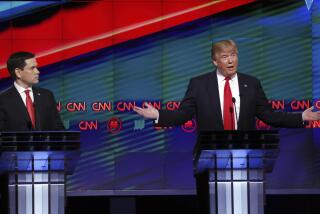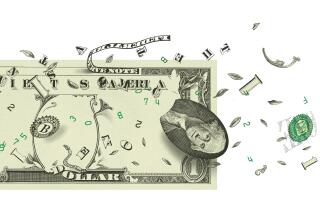Bringing Chaos Out of Chaos : THE ECONOMICS OF CHAOS On Revitalizing the American Economy <i> by Eliot Janeway (Truman Talley Books/ E.P. Dutton: $22.50; 352 pp.) </i>
What iconoclastic gadfly Eliot Janeway means by the economics of chaos is Reagonomics, and he offers a whirlwind of prescriptions to cast out the ills that he perceives. Some of them seem simplistic and many are likely to raise hackles among more orthodox economists, regardless of their ideological persuasion. For the lay reader, the book offers a stomach-churning roller-coaster ride of highs and lows, twists and turns and loop-the-loops that may have him hanging on for dear life.
Janeway postulates that the problems of the economy are due to a parallelogram of eight forces and that âthey invite solutions in pairsâ: hence the four-sided figure. This comprises 1) agricultural exports and oil imports; 2) the budget deficit and the trade deficit; 3) Social Security and the growth of the underground economy that results from regressive taxation; 4) defense and social programs.
The trade deficit, Janeway asserts, is the product of lagging agricultural exports and excessive oil imports. More direct intervention than the devaluation of the dollar, which has failed to produce anticipated results, is needed. We should pay for oil not in dollars, but with farm exports; in other words, resort to barter. To stimulate domestic oil production, we should put a quota of 50% of the U.S. market on oil imports, paying $18 a barrel to domestic producers and $5 to foreign. Janeway cites U.S. sugar quotas as precedent but fails to mention the devastating effect that these have had on the economies of such nations as the Philippines or their inflationary impact in the United States. As for what oil-producing nations would do with the mountains of U.S. food that they would have no use for, Janeway suggests that they could dispose of them, in more or less philanthropic fashion, in populous Muslim countries.
By paying for fuel imports with agricultural commodities, the farm sector would be stimulated and federal subsidies reduced. Increased oil production would revitalize the Southwest and tax revenues would be enhanced. Both the trade and budget deficits--another pair cemented together as a facet of the parallelogram--would be reduced.
An additional benefit, he conceives, would be âencouraging more people to buy more cars and trucks, and to use them more, especially for longer-distance commuting. . . .â
But no mention of what this would do to air pollution, the additional strain that would be put on the deteriorating highway system, or the probability that a portion of those burgeoning cars and trucks would be imported and thereby exacerbate the deficit.
Throughout, Janeway is long on sweeping proposals but short on details of administration or practical implementation. Free trade is moribund, he posits, and we should reemphasize reciprocity--unrestricted imports of any product would be limited to 25% of the U.S. market. It is a nationalist-Populist approach, stressing what is good for America, but giving short shrift to the effect on other economies; and it is hardly likely to be swallowed without some serious regurgitation by foreign nations. Even if it did not precipitate, as would be likely, a trade war, it might well produce a trade lock that would be just as bad.
Janewayâs position is that the U.S. market is too important and the U.S. economy and financial clout are too great for us to concern ourselves with the possibility of retaliation--a confidence that seems misplaced in the age of an integrated European community that is more than a match for the United States. Indeed, he sees the Soviet Union as a virtual client state of the United States, as well as hostage to Western Europeâs âgrid of nuclear power plants. Any shoot-out over Western Europe would scorch Russia from the skies with a giant-size Chernobyl reaction more deadly and more difficult to defend against than any launched by Genghis Khan, Napoleon, or Hitler on land.â It is an odd view that a major deterrent to a nuclear holocaust would be the effect on the Soviet Union of radiation released by devastated commercial nuclear plants in other nations; but this is an odd kind of book. It fades in on Alexander Hamilton and focuses on Thorstein Veblen, the turn-of-the-century prophet who predicted the effect of the technological revolution on society and economy. It surveys a progression of economic theorists and so proffers a panorama of political economic history.
But, repeatedly, Janeway takes the reader on detours that bewilder more than they enlighten. Not only do we get Albert Einstein, we are offered disquisitions on Dmitry Mendeleyev (the deviser of the periodic table), Konstantin Tsiolkovsky (who suggested âtwin screw propellers rotating in opposite directionsâ), and Ernst Mach (an Austro-Hungarian physicist and ballistics expert who has given his name to the terminology of supersonic speeds). In such roundabout fashion, Janeway eventually concludes: âBoth the manufacturing and the services sectors of the American economy travel on wings.â Economic revitalization, he says, âis bound to start with the aeronautical segment of her political economy. . . . Fear of flying is fatal to the economy, and so is failure to organize aeronautics. . . . The need to land, on Earth and in space, will outpace the growth of landing fields.â Ergo, we should have fewer airports and more VTOL--vertical takeoff and landing--aircraft.
By such digressions, Janeway detracts from the overview of the American economy and its future direction that he intends to present. But then, perhaps, the corollary to âThe Economics of Chaosâ has long been the chaos of economics.
More to Read
Sign up for our Book Club newsletter
Get the latest news, events and more from the Los Angeles Times Book Club, and help us get L.A. reading and talking.
You may occasionally receive promotional content from the Los Angeles Times.







